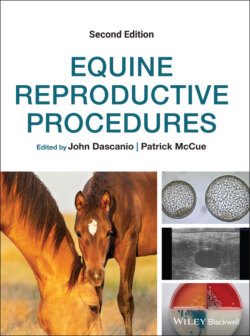Читать книгу Equine Reproductive Procedures - Группа авторов - Страница 61
Cell harvest
ОглавлениеAdd ethidium bromide solution (100 μl per 10 ml culture; final concentration 10 μg/ml) and demecolcine solution (100 μl per 10 ml culture; final concentration 0.1 μg/ml) directly into cell culture tubes or flasks and incubate for 2 hours at 37°C.Figure 22.1 A semiconfluent horse fibroblast cell culture showing many dividing cells (round and bright; arrows); magnification 20×.
Blood cultures are grown in centrifuge tubes and can proceed directly to the next step. Cells in T25 or T75 cultures flasks need to be transferred into centrifuge tubes as follows: tap the flasks vigorously to detach loosely attached cells and transfer medium with loose cells into a centrifuge tube. Next, detach the remaining cells with trypsin as described above (see “Primary fibroblast cultures”) and transfer the cells into another centrifuge tube. Use more tubes if necessary.
Spin the cells at 100× g for 10 minutes and aspirate the supernatant leaving ~1 ml medium at the bottom. Re‐suspend the cell pellet gently with a plastic fine‐tip pipette.
Add 2–3 ml pre‐warmed (37°C) hypotonic solution, gently mix the cells with a pipette, and take the volume to 10 ml. Incubate for 20–30 minutes at 37°C.
Add 500 μl of cold fixative directly into the hypotonic solution and spin the cells down at 100× g for 10 minutes.
Aspirate the supernatant and gently re‐suspend the cells so that no clumps remain; add ~1 ml fresh fixative and mix the cells again; take the fixative volume to 5 ml, spin the cells at 100× g for 10 minutes, aspirate the supernatant, and repeat the fixation step three more times.
Aspirate most of the supernatant, leaving cells in ~200 μl fixative. Re‐suspend the cells by gentle pipetting and transfer the fixed cell suspension from 15 ml centrifuge tubes into 1.5–2.0 ml microcentrifuge tubes. Store the cell suspensions at –20°C (–4°F) until needed.
